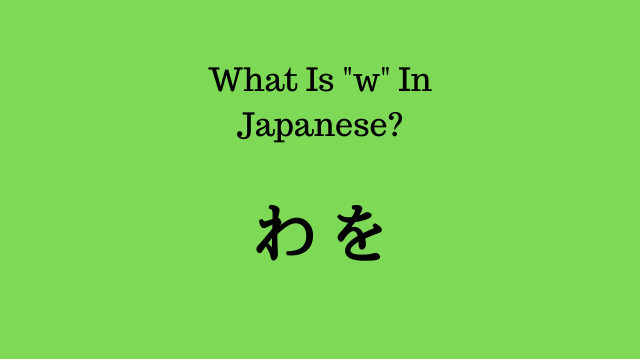We have finally arrived at the last lesson for the basic sounds (and hiragana) of Japanese. This one is going to be interesting because of the material we are going to cover. What is “w” in Japanese?
There are only two sounds that fall into this category, but sometimes only one of them actually uses a [w] sound!
We are also going to cover a special Japanese character. It is the only consonant in the language that does not get paired up with a vowel. In addition to that, it can have up to four different sounds!
I am also going to provide you with some free charts that you can download and use to help remember (or practice) what you’ve learned so far, but first, let’s dive into the sounds.
The 2 Japanese [w] Sounds and ん
This first part ought to be fairly straightforward since the [w] sound is the same in English and Japanese. It gets combined with each of the two following vowels to create the following:
わ = wa
を = wo
Then we have the hiragana ん which can be any of the four following sounds: [n], [m], [ng], or [N].
I’ve devoted an entire section below to explaining when it uses each one, so for now let’s just listen to the audio for this lesson.
Alright, let talk about ん now and then there is some additional information that I would like to give you on を.
Special Notes On The ん Sounds
As for the ん sound, it is actually pretty special since it is the only consonant in Japanese that doesn’t get combined with a vowel.
This actually comes into play when the Japanese game shiritori, but that’s another topic entirely.
The reason for this is because ん is never used at the beginning of a word. You will only ever hear it in the middle of, or at the end of a syllable or word.
In addition to that, the sound will change slightly depending on the consonant or vowel that immediately follows it.
That last part I mentioned is key.
I’m going to give you the sounds right now, but I want to remind you that the motto of this course is to “always follow your ears.” Use what I’m about to say as a guide, but trust in your own intuition and abilities to understand this sound.
The more focused time you spend listening to Japanese, the better you will become at it.
Alright, you will normally pronounce ん as [n] just like you did with な-に-ぬ-ね-の in an earlier lesson. To get more technical on this topic, you will make this sound by lightly pressing the tip of your tongue to the roof of your mouth.
As a side note, I always thought that ん looked like a lowercase “n” in English, so it was always super easy to remember!
Other situations where you pronounce ん differently:
1. Pronounce ん as [m] like you did with ま-み-む-め-も when it comes right before a [m], [p], or [b] sound.
2. Pronounce ん as [ng] (like the “ng” in the English word “song”) when it comes before a [k] or [g] sound.
3. Pronounce ん as [N] when it comes at the end of a word and there is nothing after it.
Unfortunately, this last [N] sound doesn’t exist in English, so I can’t give you an example word that you would be familiar with, but it is actually pretty close to the [ng] sound that I just explained previously, so you can start there and work on noticing the difference.
In fact, from what I’ve learned most Japanese people will switch between [ng] and [N] subconsciously without even noticing that they did it themselves, so if you can do one of these two sounds then you can just use it and still sound like a native!
Special Notes On The [wo] Sound
Something I want to briefly touch upon is the を [wo] sound in Japanese. Technically speaking, the correct way to pronounce this kana is [wo].
This is how it was originally used, and people from the older generations are likely to use it more often than the younger generation.
As all languages do over time, Japanese is changing and now it is more common to just say [o] for this symbol.
You might be worried about confusing it with お since they typically sound identical, but を is used for certain grammatical reasons, so there’s no need to worry about accidentally swapping the two of them. You’ll know the difference during conversation.
Since both [wo] and [o] are correct readings for を you can use which ever one you prefer. If you’re not sure which to use, then just go with [o] as it will sound more natural nowadays.
Also, no matter which one you end up going with, I would recommend that you be consistent and use it every time, rather than switching between the two.
Down below in the comments section, Kim provides a little more detail on を and I think it’s worth checking out if you have the time to do so.
The Final Writing Practice
Yep, you read that right. This is the last time that I will ask you to write out hiragana!
Don’t worry, this isn’t some trick where I’m going to have you start writing in katakana or kanji. The reason is becuase once you have completed this section, you will have learned how to correctly write all of the basic hiragana.
The next couple of sections will go over the modified and combination kana, which are these same basic ones with some small changes.
わ = wa

を = wo

ん = n

In the last lesson I told you that I was going to give you yet another way to practice hiragana. The trick is that you’ve actually been using it already throughout this course.
I’m talking about reading!
Since hiragana is the first of the three Japanese writing systems, it is what Japanese children learn first. This means that there are actually a lot of children’s books written entirely in hiragana that you can read to practice these symbols.
Although it might not be the most efficient thing to start reading when you don’t know the basic words or grammar yet, it’s something that I wanted to provide to you as a resource in case you were interested.
There is a really great website called Crunchy Nihongo that has some Japanese children’s stories written entirely in hiragana, with the option to show romaji and the English translation for the words.
Click Here To Practice Reading Hiragana
If you do decide to read some of the stories, be sure to let me know which ones you enjoyed the most!
Time For Your Free Charts!
I wanted to provide you with two hiragana charts that you can download to your phone or computer and print out (if you want to).
The first one is simply a chart that shows all of the basic hiragana that you have learned. You can use it for quick reference any time in the future.
The second one shows the correct stroke order of each character so that you can continue to practice writing them correctly.
Something that I should mention about this second chart is that it is organized a little bit differently from the first one. It starts in the top right corner and then goes down to the bottom of the page.
This is actually the way native Japanese is normally written in books and such: From top to bottom, and then from right to left.
It ought to be a nice introduction to vertical writing in Japanese for you!
-Download the first chart by clicking here.
-Download the second chart by clicking here.
P.S. I’ve cleaned up this second chart a little bit so that it is more appropriate for the knowledge we’ve gone over so far. The original version created by Pmx can be found on the Wiki Commons by clicking here.
Later on I will provide you with some more charts in hiragana that contain the modified and combination sounds that we have yet to cover.
But since you’ve come this far in our journey together, I wanted to give you a gift that you can find helpful.
ん, んん Good. Good Words That Is!
You’ve come a long way. I’m proud of you!
Let’s keep it going with some more examples to listen to.
わたし = I (me)
わらい = Laugh
みんな = Everybody (this is the [n] sound)
あんまり = Not much (this is the [m])
はんき = Half-time (this is the [ng] sound)
ほん = Book (this is the [N] sound)
I’m Going Easy On You This Time
I don’t really think you need to practice these individual sounds all too much since we only covered three new kana and they are pretty easy for most people to pick up.
So just do these two things:
- Write down each kana a minimum of five times.
- Rehearse the words five times each.
In the next lesson we are going to start learning the modified sounds and their hiragana. If this sounds intimidating at all, then rest assured that it’s not.
In fact, I would say that these upcoming sounds are actually easier than the ones you’ve learned so far!
Are you excited?
I’m excited!
Get excited! ٩(^ᴗ^)۶
Go to the Table of Contents
Go to the next lesson
Further Resources for Learning Japanese:
#3 Get My eBook (Secrets to Learning Japanese) for Free

またね!

I actually just watched a video by Dogen today on the を sound and how you are supposed to pronounce it! He basically said the same thing, that either way is correct as long as you pick one and stay consistent with it.
Something I didn’t know before was that (wo) is historically correct, which is why a lot of people still use it, but (o) is the “correct” way to pronounce it in Modern Tokyo Dialect.
Something that other readers who don’t follow Dogen might benefit from is that if you choose to use the old pronunciation of を, it should be less of a (wo) sounds and more of a ぅお sound. Start with a little ぅ and then move to the primary お sound.
Haha, hey I support Dogen on Patreon too! I watched that lesson as well and was pretty impressed. I had never heard about pronouncing 「を」 as 【ぅお】 before, but he convinced me in a few seconds with his explanation and audio examples.
At any rate, I pronounce it as 【お】so there’s no problem on that end of things.